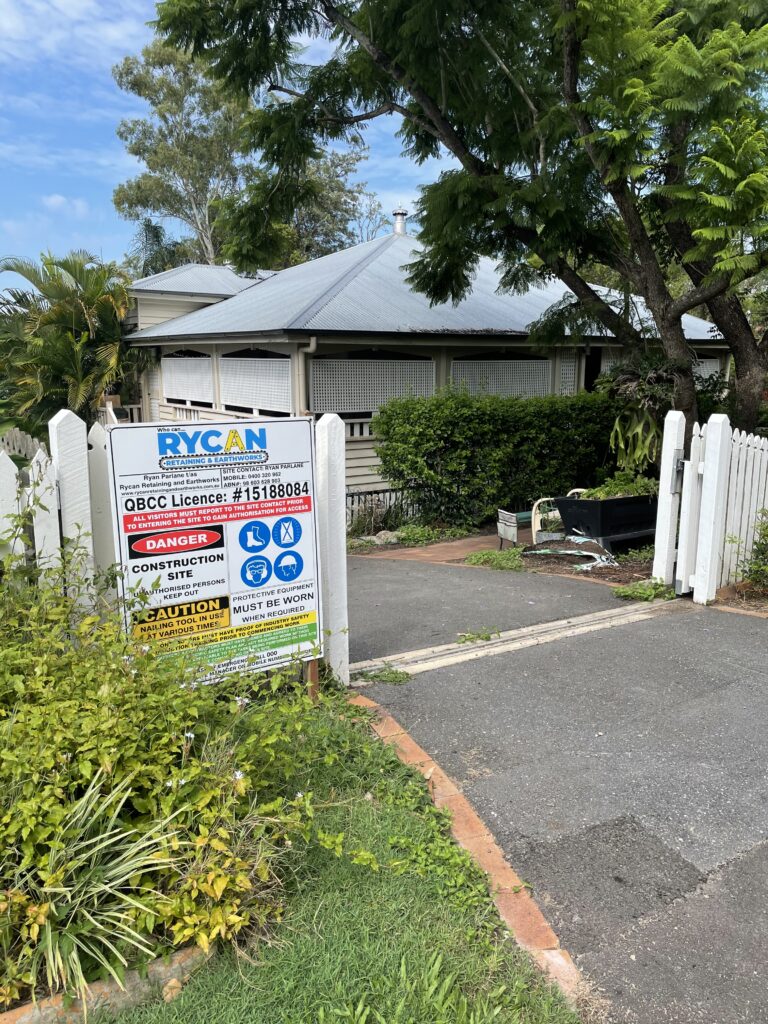Retaining Wall Engineering, Building Approval, and Certification – The Law and Process in Brisbane and Ipswich Regions

In Queensland, any retaining wall that satisfies any of the following points will be required by law to have engineering plans drafted by an RPEQ registered Engineer, local Council Building Approval, a QBCC Licenced Builder (qualified in retaining wall construction) construct the wall, and the final structure signed off by a Certifier.
- The total height of the wall and the fill or cut retained by the wall is more than one metre above the wall’s natural ground surface.
- There is ‘surcharge loading’ over the ‘zone of influence’ of the wall, despite the height of the wall, meaning the wall supports the foundations of a house, shed, pool, or fence attached to the top of a wall or within one metre of a fence. (Refer to definitions in the Building Regulation 2006 (Schedule 1 Section 3)
- the wall is within 1.5 metres of a building, shed or another retaining wall
- the wall is within 3 metres of a pool
- the wall forms part of a pool fence
- the wall is within 3 metres of underground utilities or an easement
Check out our Navigating Retaining Wall Law Flow Chart to assist you in hiring the right professionals and understanding your structures’ legal requirements. Additionally, the Ipswich City Council has a fantastic Information Pack outlining Council laws relevant across Brisbane City Council and Ipswich City Council relating to retaining walls.
Pro Tip:
- You can drive around your suburb and observe what retaining walls are erected in nearby properties. Suppose you find that most retaining walls in your area are gravity walls, e.g., sandstone, boulder, or gabion cage. In that case, the soil type within your area is likely a type of rock that can cost more if you opt for a piered retaining wall structure, e.g., a concrete sleeper with galvanised steel post, timber, etc. For more info, please look at the Queensland Government common soil type examples.
- Please look at the space available to construct your retaining wall and store material. If you have limited space and the retaining wall is on a boundary with a fence on top, then you will most definitely have to opt for a piered retaining wall. If your property has plenty of land without obstructions for heavy machinery and large rock material delivery, then a gravity wall may be the better option. Also, make sure you look up! Powerlines or large trees can hinder your construction plans.
- Perform a Dial Before You Dig search on your property address. Dial Before You Dig won’t usually tell you what service or underground infrastructure is within your property boundary. Still, it can give you clues as to what side of your property any services are running from or through. It will also tell you if you have any easements within your property that may need to be considered when planning your structure.
- Suppose you have building plans or existing Council documentation relating to your property, including a soil test, existing building approvals, or utility plans. These documents can be a significant time and money saver in that case.
Step 1: Structural Engineer
Your first port of call will be contacting a Structural Engineer. Ideally, you want a local professional, saving you money on site visit transport costs. Additionally, suppose the Engineer is local to your location or works within your area regularly. In that case, they will understand the geological landscape (the soil type), potentially saving you further money on soil testing and potential delays to the process.

Don’t be afraid to discuss your findings from our Pro Tip above and your preference in retaining wall type with your Engineer. Although it’s super important to choose the correct structure for your soil type, space, and purpose, you want to ensure that the wall fits in with your budget and the overall aesthetic of your property. Any experienced and professional Engineer will work with you to achieve the best structure for your property.
Sometimes, the Council may require a Soil Test and the report supplied to them as part of their application process. When you request a quote for your Engineering services, please ensure that they include all potential fixed and circumstantial charges so you understand the cost completely. These charges can include:
- an initial site inspection fee for plans to be drafted
- utilities, easements, and underground infrastructure searches
- soil testing
- drafting of engineering plans and associated Form 15
- geotechnical report (if your structure is on a riverbank or within a Council-identified zone e.g., flood zone or flora and fauna zone)
- Up to two inspections, by a qualified Engineer, of the structure during the construction phase, resulting in issuing a Form 15 – Compliance certificate for building design or specification per visit.
Pro Tip:
- A Form 15 in Queensland is used to certify the design of particular systems or components within a building phase of a structure that is outside of the Building Certifier’s expertise or not visually available to them when they perform the final inspection, e.g., pier holes are drilled to the correct depth, the footings or foundations of a structure have been installed to the specification, the drainage system installed behind a retaining wall has been completed in line with the specification.
Step 2: QBCC Licenced Builder
Once your Engineer has sent you the ‘draft’ engineering plans for your structure, the next step is to contact a qualified QBCC Licensed Builder with the capabilities, i.e., machinery, skill, and experience, to construct your type of structure.
Send the QBCC Licenced Builder the drafted plans from the engineer and request a site visit before getting your final quote. A preliminary quote, subject to site inspection, is acceptable for the initial costings of the project. Still, the retaining wall contractor must perform an on-site inspection before confirming the service and contracting their services. By completing an on-site assessment before contracting the builders’ services, the Builder and the customer are minimising any unforeseen obstructions that could result in a variation (cost increase) to the contract during the construction phase.

Additionally, a builder can request changes be made to the engineering plans if the plans don’t correlate with the actual site conditions, e.g., machinery access hasn’t been considered, the Engineer has over-engineered the structure beyond the Australian Building Code standards, once excavation begins the soil type is different or an unforeseen obstruction arise. Once the construction is completed and the Certifier has signed off on the project, the Builders license number will be noted within the final submission to the Council.
Things to note when commissioning the services of a QBCC Licenced Builder:
- Deposits. Maximum deposit percentages are set out in Schedule 1B of the QBCC Act 1994 and must not be exceeded:
- 10% of the total contract price if under $20,000 Inc. GST
- 5% of the total contract price if $20,000 Inc. GST or more.
- collected from you and paid to the QBCC by the contractor
- included as part of your contract
- paid before work begins
- Compulsory for all residential construction work valued at over $3,300 (including materials, labour, and GST). Except for retaining walls or fences that don’t support the foundations of a dwelling or shed.
Pro Tip:
- As stated on the QBCC website, ‘In Queensland, individuals (sole traders), and companies must hold a QBCC licence to carry out (contract for) building work valued over $3,300 Inc. GST or of any value where it involves: drainage.’ More to the point, depending on the material used to construct your retaining wall, you can hire a QBCC Licenced Builder – Open Class or QBCC Licenced Builder – Structural Landscaper. The type of wall you want to build will determine the kind of QBCC Building Licence your builder will need to hold.
- QBCC Licence holders are required to always carry their physical licence on them, just like a driver’s licence. Upon request, a QBCC Licence holder must present their licence to you. On the back of their licence, it will state what kind of licence they hold along with what kind of material/ structure/ services they are qualified in and licenced to build or perform.
- Master Builders QLD has an excellent search engine, Find a Master Builder, that can assist you in finding a QBCC Licenced Professional who operates in line with QLD legislation.
Step 3: Certifier/ Council Building Application Lodgment & Approval
A Certifier can submit the Council Building Approval application and the engineering plans to the Council on your behalf, should you not want to submit them yourself. Once the Council approves your Building Application and associated plans, you will be able to go ahead with the project’s construction phase.

Once construction is completed, the Certifier will then return to the site and perform a final inspection on behalf of the Council and provide you with a Form 16 – Inspection Certificate, which will list any defects that the Builder must rectify before issuing the Form 21 – Final Inspection Certificate once the work is completed to their satisfaction. The Certifier will then submit all forms along with the Engineers Form 15, and the structure will be completely legal and recorded within the Council’s records.
Brisbane City Council –
- Suppose your property is located within the Brisbane City Council region. In that case, we highly recommend hiring a private Certifier to lodge your Council Building Application forms and perform your final Certification Inspection once the structure has been built. Brisbane City Council offer a Certifier service, but trying to contact their Building and Development Department can take time. Hiring a private Certifier will remove much of the stress and confusion many face when dealing with Council documentation and ensure documents are lodged correctly, thus avoiding unnecessary delays and potentially costly errors as most Council fees are non-refundable.
- As of 1st July 2023 – All building structures Classes 1–10 inclusive and special structures where Notice of Engagement, Decision Notice, Final Notice/Certificate of Occupancy, and attachments lodged via the Brisbane City Council portal. All documents are lodged via the internet. The fee for online lodgments is $69.65 Inc. GST
BCC Building Approvals and General Information:
BCC Information for Private Certifiers:
BCC Lodgment and Online Applications:
Ipswich City Council –
- ICC provides, to its residents, a comprehensive and user-friendly resource hub within their website.
- As of 1 st July 2023, fee schedule – the ICC assessment fee for a Class 10b – Retaining Wall/Fence (excluding Swimming Pool fencing) is $590.00 Inc. GST.
- ICC have Certifiers on staff that you can book in advance should you decide to do the application process yourself and just have their Certifier sign off the final structure.
ICC Building Approvals and General Information:
ICC Retaining Wall Information Pack:
Pro Tip:
- Building Regulation 2006 advises building approval is not required if a proposed fence is no higher than two metres above the natural ground surface. However, you will need building approval for a regulated pool fence. When a fence is attached to the top of a retaining wall, the retaining wall and fence structure are considered one combined structure. So, if the retaining wall and fence height exceeds 2 metres from natural ground level, you must lodge an additional application to the Council requesting a relaxation of the law. A Certifier can assist you with this process.
Our Service Locations
RYCAN Retaining and Earthworks has been servicing the Brisbane Western Suburbs, and Ipswich Region in Queensland for over 10 years. We are passionate about helping you realise the true potential and beauty of your property while providing long-lasting structures and expert earthmoving services.





